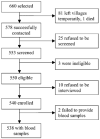Hepatitis C virus infection in former commercial plasma/blood donors in rural Shanxi Province, China: the China Integrated Programs for Research on AIDS
- PMID: 16235166
- PMCID: PMC2730763
- DOI: 10.1086/497148
Hepatitis C virus infection in former commercial plasma/blood donors in rural Shanxi Province, China: the China Integrated Programs for Research on AIDS
Abstract
Background: Unsafe practices during illegal plasma donation in the late 1980s and early 1990s spread bloodborne infections in central China.
Methods: A cross-sectional survey of a random sample of 538 adult residents of 12 villages in rural Shanxi Province, where there had been an illegal commercial plasma-collection center, was conducted in 2003. Structured questionnaires were administered, and blood samples were tested for hepatitis C virus (HCV) antibodies.
Results: HCV seroprevalence rates were 8.2% in all subjects, 27.7% in former commercial plasma/blood donors, and 2.6% in nondonors. Selling blood or plasma was the strongest independent predictor of HCV seropositivity (odds ratio [OR], 14.4 [95% confidence interval {CI}, 7.1-31.6]). A history of blood transfusion was also independently associated with HCV seropositivity (OR, 8.3 [95% CI, 2.1-32.0]). Plasma donors had a higher risk of being HCV seropositive than did whole-blood donors (OR, 7.6 [95% CI, 2.9-20.9]), and female donors had a lower risk than did male donors (OR, 0.32 [95% CI, 0.12-0.80]). The strength of the association between selling blood and HCV seropositivity was weaker when plasma donors were excluded (OR, 8.0 vs. 14.4).
Conclusions: Unsafe practices during illegal plasma donation led to a high risk of HCV seropositivity for donors during the 1980s and 1990s. Failure to screen for HCV increased the risk of seropositivity for transfusion recipients during this same period. China has taken steps to halt illegal plasma collection and to improve blood-banking methods. However, there will be an ongoing challenge to care for patients with HCV infection, even as its incidence decreases.
Conflict of interest statement
Potential conflicts of interest: none reported.
Figures
Comment in
-
Plasma collection and donor safety in rural China.J Infect Dis. 2005 Nov 15;192(10):1681-2. doi: 10.1086/497154. Epub 2005 Oct 6. J Infect Dis. 2005. PMID: 16235163 No abstract available.
Similar articles
-
Co-infection with HIV and hepatitis C virus in former plasma/blood donors: challenge for patient care in rural China.AIDS. 2006 Jun 26;20(10):1429-35. doi: 10.1097/01.aids.0000233577.33973.fa. AIDS. 2006. PMID: 16791018 Free PMC article.
-
Prevalence and risk factors of hepatitis C among former blood donors in rural China.Int J Infect Dis. 2012 Oct;16(10):e731-4. doi: 10.1016/j.ijid.2012.05.1035. Epub 2012 Jul 15. Int J Infect Dis. 2012. PMID: 22796320
-
Risk factors of hepatitis C virus transmission and genotype distribution in former blood donors from Chinese rural area.BMC Public Health. 2015 Feb 25;15:184. doi: 10.1186/s12889-015-1535-6. BMC Public Health. 2015. PMID: 25884321 Free PMC article.
-
Epidemiology of hepatitis C virus in Ghana: a systematic review and meta-analysis.BMC Infect Dis. 2016 Aug 9;16:391. doi: 10.1186/s12879-016-1708-7. BMC Infect Dis. 2016. PMID: 27507267 Free PMC article.
-
Insights into the epidemiology, natural history and pathogenesis of hepatitis C virus infection from studies of infected donors and blood product recipients.Transfus Clin Biol. 2001 Jun;8(3):200-6. doi: 10.1016/s1246-7820(01)00125-2. Transfus Clin Biol. 2001. PMID: 11499958 Review.
Cited by
-
Prevalence of hepatitis C virus infection and its correlates in a rural area of southwestern China: a community-based cross-sectional study.BMJ Open. 2017 Aug 11;7(8):e015717. doi: 10.1136/bmjopen-2016-015717. BMJ Open. 2017. PMID: 28801405 Free PMC article.
-
Changing baseline characteristics among patients in the China National Free Antiretroviral Treatment Program, 2002-09.Int J Epidemiol. 2010 Dec;39 Suppl 2(Suppl 2):ii56-64. doi: 10.1093/ije/dyq215. Int J Epidemiol. 2010. PMID: 21113038 Free PMC article.
-
Co-infection with HIV and hepatitis C virus in former plasma/blood donors: challenge for patient care in rural China.AIDS. 2006 Jun 26;20(10):1429-35. doi: 10.1097/01.aids.0000233577.33973.fa. AIDS. 2006. PMID: 16791018 Free PMC article.
-
Liver Damage in Patients with HCV/HIV Coinfection Is Linked to HIV-Related Oxidative Stress.Oxid Med Cell Longev. 2016;2016:8142431. doi: 10.1155/2016/8142431. Epub 2016 Jan 10. Oxid Med Cell Longev. 2016. PMID: 26881041 Free PMC article.
-
HIV-infected former plasma donors in rural Central China: from infection to survival outcomes, 1985-2008.PLoS One. 2010 Oct 29;5(10):e13737. doi: 10.1371/journal.pone.0013737. PLoS One. 2010. PMID: 21060835 Free PMC article.
References
-
- Koff RS, Hepatitis C. In: Infectious diseases. 2nd. Gorbach SL, Bartlett JG, Blacklow NR, editors. Philadelphia: W. B. Saunders; 1998. pp. 864–71.
-
- Liu CB. Epidemic and risk factors of viral hepatitis in general population in China. Zhongguo Gan Bing Za Zhi. 1998;6:67–70.
-
- Garten RJ, Lai S, Zhang J, et al. Rapid transmission of hepatitis C virus among young injecting heroin users in southern China. Int J Epidemiol. 2004;33:182–8. - PubMed
-
- US Centers for Disease Control and Prevention. National Hepatitis C prevention strategy. [1 May 2005]. Available at: http://www.cdc.gov/ncidod/diseases/hepatitis/c/plan/HCV_infection.htm.
Publication types
MeSH terms
Substances
Grants and funding
LinkOut - more resources
Full Text Sources
Medical


